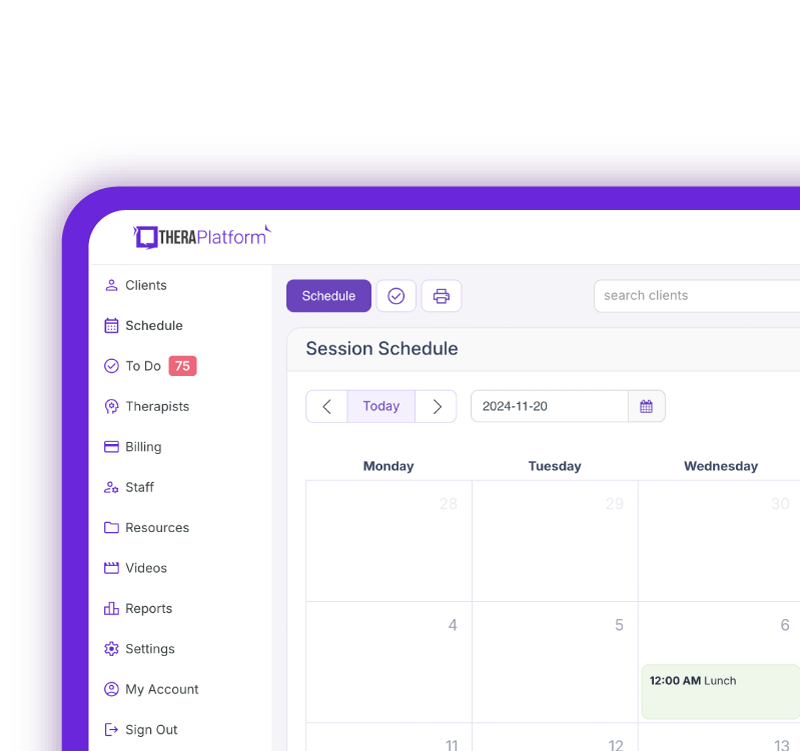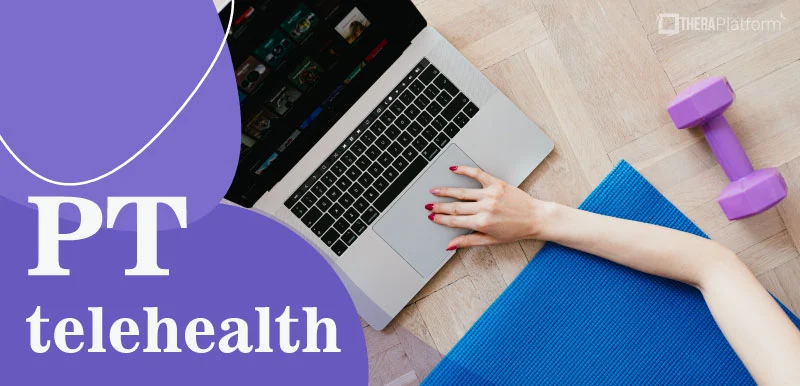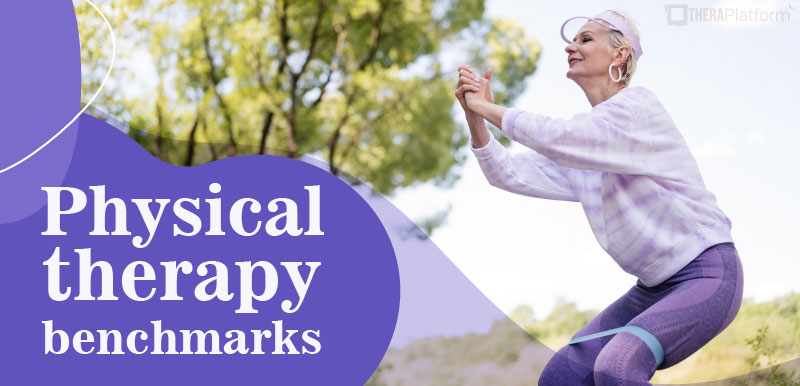Physical therapy home exercise programs

Physical therapy home exercise programs are a staple of every PT program and one important building block for meeting your clients’ goals for managing pain, decreasing symptoms, promoting recovery and improving their level of function.
Summary
- Physical therapy home exercise programs (HEPs) play a crucial role in helping clients achieve their rehabilitation goals beyond in-clinic sessions. These programs address key areas such as pain management, symptom reduction, recovery promotion, and functional improvement.
- A well-designed HEP should prioritize safety, proper exercise dosage, and structured warm-up and cool-down routines.
- HEPs include a variety of exercises tailored to strength, flexibility, and balance goals. Strength training involves resistance exercises like push-ups, squats, and lunges, while flexibility routines incorporate dynamic and static stretching for mobility.
- EHRs, like TheraPlatform, enhance HEP effectiveness by enabling therapists to share exercise instructions, track client progress, and communicate securely. Clients benefit from structured guidance and regular check-ins, which improve adherence and outcomes.
Streamline your practice with One EHR
- Scheduling
- Flexible notes
- Template library
- Billing & payments
- Insurance claims
- Client portal
- Telehealth
- E-fax

While clients may find it easier to do exercises under the direct supervision of a therapist, there are many benefits to doing prescribed physical therapy home exercise programs.
There are also some considerations and protocols for administering physical therapy home exercise programs.
- Dose matters. A certain amount of stretching must be performed daily or weekly before your client will see increased flexibility; so many resistance training sessions are required to build muscle strength and a certain amount of balance practice must be completed before you will experience improved balance.
- In many instances, the 1-3 sessions you complete with your client weekly are not enough to achieve the dose needed to meet your client goals. A physical therapy home exercise program helps fill in the gap so clients can achieve meaningful change. There is not much physical therapists hate more than to see clients make slow or no progress because of underdosing during physical therapy home exercise programs.
- Physical therapy home exercise programs help prepare clients to transition out of PT and into a maintenance routine that they can manage. As much as we love working with clients, we can’t do so forever.
At some point, clients will be discharged from our care and expected to use the training and knowledge acquired in physical therapy to maintain their improvements. Getting into the habit of performing a physical therapy home exercise program is the best way to support their progress in therapy and maintain it afterward.
Practice Management + EHR + Telehealth
Mange more in less time in your practice with TheraPlatform

.
Considerations when building a physical therapy home exercise program
A physical therapist will customize a physical home exercise program to meet a client’s specific needs and recovery goals, however, we want to show clients how many exercises can be performed inside the home with minimal to no equipment.
Safety
The first topic to address is safety. Below are some important safety considerations when beginning a physical therapy home exercise program:
- Always have clearance before beginning a new exercise routine
- Ensure a safe, clutter-free space for exercise
- Have water nearby and a place to rest as needed
- Have clients monitor for symptoms of pain, lightheadedness, shortness of breath or other signs of discomfort. Instruct clients to stop exercising if these symptoms arise and speak with you or their doctor if pain persists or other symptoms continue
- Focus on good posture and technique as this helps decrease the chance of injury. Increasing the difficulty of an exercise is only helpful if they can maintain good form and technique as it’s performed.
Warm-ups
Warm up first: It is important to warm up before exercise to reduce injury risk and help tissues prepare for work. Spending 5-10 minutes warming up can be very helpful. Here are some ways to warm up before exercising:
- Light cardiovascular exercise
- Start low and slow on a bike, elliptical or treadmill and slowly increase the speed or resistance to allow heart, lungs and muscles to accommodate to the new work
- Spend a few minutes moving:
- Marching in place while swinging arms
- Stepping side to side
- Arm circles
- Body weight squats
- Quick walking
- Light resistance training
- If using resistance tools such as bands, weights or cables, begin each exercise with a set at lighter resistance. This allows the body to prepare for the heavier weight and also gives your neuromuscular system time to warm up and practice the motion
- Static stretching: Static stretching involves holding a stretch position for 15-60s. Performing static stretching before exercise may decrease muscle power and increase injury risk. Static stretching is best done after exercise while dynamic stretching is helpful to perform before exercise.
Incorporating dynamic stretching
Dynamic stretches, unlike static stretches, involve moving in and out of a stretch position carefully and with good control to help warm up muscles and tendons.
Dynamic stretching exercises | Description |
|---|---|
Front and back leg swings | Hold onto a wall or counter and shift weight onto one leg. Slowly kick the opposite leg behind you and in front of you 10-15x slowly increasing the size of the kick as you warm up. |
Walking quad stretch | Take a step forward while reaching down and grasping the foot or ankle of your opposite leg, bending the knee and bringing the foot toward your backside. Hold for 1-2s then release the foot as you step it forward. Repeat on the opposite side for 15-20 steps. If needed, hold onto a wall or counter for balance with your free hand. |
Lateral lunge | Stand upright; take a large step to the side and hinging forward at the waist, stick your hips out behind you as you transfer your weight onto that leg, squatting low; your opposite leg will remain stretched out long to your side. Push up from that position and step back to the start. Repeat 10-15x per side. |
Heel-toe rocks: | Holding onto a support surface as needed, raise up on your toes then lower back to the ground and pull your feet up toward your shins. Continue alternating for 15-20 reps. |
Arm circles | Reach your arms out to your sides, elbows straight; circle your arms forward beginning with small circles and ending with large circles. Perform 10-15 circles then repeat the opposite way. |
Posterior shoulder stretch | Standing tall, bring one arm across your chest toward your opposite shoulder; using the free hand grasp behind your arm, pulling it gently into your chest to stretch the back of your shoulder; release it and repeat on the opposite side; perform 10 reps per side |
Physical therapy home exercise program for strength building
Strengthening and muscle endurance exercises: To build strength or endurance, aim for 1-3 sets of exercises performed 2-3x per week. To build strength exercises should require a moderate (if you are new to exercise) to hard (if you are experienced and can maintain good form and perform without pain) effort to complete.
To build muscle endurance, exercises will require light to moderate effort to complete. Strength-building exercises are usually performed in sets of 8-12 reps while endurance exercises might require 15-25 reps. Below are some examples of a physical therapy home exercise program for strengthening.
Upper body exercises | Trunk/abdominals exercises | Lower body exercises |
|---|---|---|
Push ups, elevated push-ups, wall push-ups | Plank: On hands, on forearms, on feet/knees, elevated: Side plank: On hand, on forearm, on feet, on knees | Glute Bridges: Double leg, single leg, single leg with hamstring curl using slider |
Bicep curls | Pelvic tilt | Clamshells: body weight, with band |
Tricep dips | Bird dog | Side lying straight leg raise |
Tricep overhead press | Supine transversus abdominis (TA) activation | Standing hip abduction |
Straight arm pulldown | Lower trunk rotation | Lateral stepping with band around ankles or knees |
Standing or bent over rows | Supine march with TA activation | Pillow squeeze for inner thigh muscles |
Wrist curls | Dead bug | Squats |
Wrist extension | Lunges: forward, reverse, walking | |
Chest press | Lateral lunges | |
Lateral shoulder raise | Step up, step down | |
Calf raises: single leg, double leg | ||
Toe raises | ||
Ankle 4 way with band |
Physical therapy home exercise program for flexibility and mobility
Flexibility and mobility exercises: These can be performed dynamically (before exercise, as warm up for example) or statically (between bouts of exercise or after exercise). Dynamic stretches and mobility exercises are often held in the stretch position for a few seconds and repeated 10-20 times for 1-2 sets while static stretches are usually held for 30-60s for 1-3 sets daily
Upper Body exercises | Spine exercises | Lower body exercises |
|---|---|---|
Arm circles | Gentle seated spinal twist | Single or double knee-to-chest |
Wrist circles | Open books | Ankle circles |
Wrist flexor stretch | Thread-the-needle | Hip circles |
Wrist extensor stretch | Child’s pose stretch | Hamstring stretch |
Bicep stretch | Neck circles | Calf stretch |
Triceps stretch | Upper trap stretch | Standing or prone quad stretch |
Doorway pec stretch | Levator scap stretch | Adductor stretch |
Kneeling prayer lat stretch | Figure 4 stretch | |
Half kneel hip flexor stretch |
Physical therapy home exercise program for balance/coordination
Balance and coordination exercises: Stand near a support surface or back yourself into a corner with a sturdy chair in front for safety; recommend having someone stand close to you if you are worried you may fall. More is better when it comes to building balance but you should take a break if your concentration is waning or muscles are getting tired.
- Feet together eyes open and eyes closed
- Feet together while turning head left and right or up and down
- One foot slightly ahead of the other
- Heel-toe stance
- Single leg balance
- Walking heel-toe
- Tapping a cone or box with one foot
- Step-ups
- Sidestepping
Cool down and relaxation exercises
Cool down and relaxation exercises. Aim to spend 5-10 min cooling down to prevent injury and allow your heart and lungs to return to baseline.
- Slow down the speed and effort of aerobic exercise to allow your heart rate to normalize before stopping
- Stretching (see above)
- Diaphragmatic breathing: breathe into the belly first then breathe into the chest, exhale from the chest and then from the belly, repeat for a few minutes to relax you
- Breathe in for 4-5s and out for 6-7s
- Neck circles
- Lower trunk rotation
Tracking your exercises is a great option for monitoring your clients’ progress, keeping note of any questions or concerns and communicating with your client. Consistency is key when doing your home exercises. Work with your client and show how their hard work and progress helps with their goals.
Streamline your practice with One EHR
- Scheduling
- Flexible notes
- Template library
- Billing & payments
- Insurance claims
- Client portal
- Telehealth
- E-fax

Resources
TheraPlatform is an all-in-one EHR, practice management, and teletherapy software built for therapists to help them save time on admin tasks. It offers a 30-day risk-free trial with no credit card required and supports different industries and sizes of practices, including physical therapists in group and solo practices.
Through TheraPlatform’s therapy client portal, you can share handouts and homework instructions with clients. You can also communicate with them directly through secure messaging. Regular check-ins with your clients can help you progress your program safely and ensure your questions are answered.
More resources
- Therapy resources and worksheets
- Therapy private practice courses
- Ultimate teletherapy ebook
- The Ultimate Insurance Billing Guide for Therapists
- The Ultimate Guide to Starting a Private Therapy Practice
- Mental health credentialing
- Insurance billing 101
- Practice management tools
- Behavioral Health tools
Free video classes
- Free on-demand insurance billing for therapist course
- Free mini video lessons to enhance your private practice
- 9 Admin tasks to automate in your private practice
References
Behm DG, Blazevich AJ, Kay AD, McHugh M. Acute effects of muscle stretching on physical performance, range of motion, and injury incidence in healthy active individuals: a systematic review. Appl Physiol Nutr Metab. 2016 Jan;41(1):1-11. doi: 10.1139/apnm-2015-0235. Epub 2015 Dec 8. PMID: 26642915.
Kisner & Colby. Therapeutic Exercise Foundations and Techniques (8th edition). F.A. Davis Company. 2022.



